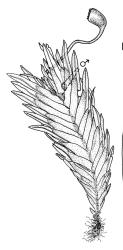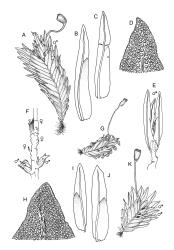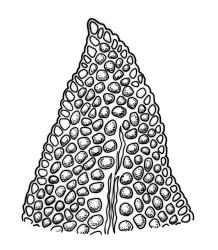- ≡ Fissidens oblongifolius var. capitatus (Hook.f. & Wilson) Hook.f. & Wilson in Wilson, Bot. Antarct. Voy. II (Fl. Nov.-Zel.) Part II, 62 (1854)
Plants 5–15 mm, mid green to yellow-green, densely gregarious. Stems frequently branched by subgametoecial innovations, with rhizoids at base only. Leaves in 12–20(–30) pairs, overlapping at mid stem, patent, plane when moist, with apices loosely and irregularly inrolled away from the substrate when dry, linear-lanceolate, 2.0–3.0 × 0.3–0.4 mm; apex acute to acuminate; laminae unistratose; vaginant laminae ½–⅔ leaf length, partially closed to closed; dorsal lamina usually ending at leaf insertion, truncate at base; margins serrulate-crenate on apical, dorsal and vaginant laminae, with cells of supra-basal vaginant lamina margins isodiametric to oblate; cells of apical and dorsal laminae irregularly hexagonal, smooth, strongly bulging, with moderately thick walls, (6.0–)7.5–12.0(–13.5) × (6.0–)7.5–12.0(–13.5) µm. Costa failing below leaf apex, oblongifolius-type in cross-section.
Heteroicous. Gametoecia consisting of short shoots, usually in axils of upper leaves or terminal on main shoots, usually unisexual with sexes in close proximity, or occasionally synoicous. Perichaetia terminal or in axils of upper leaves, leaves narrower than vegetative leaves in dorsal and apical laminae. Perigonia inconspicuous, with leaves similar to vegetative leaves. Setae light brown, often tortuose above, 4–5 mm; capsules horizontal, strongly asymmetric, 0.5–1.0 mm; operculum rostrate from a conic base, equal in length to theca. Peristome similiretis-type; teeth 60–75 µm wide at base. Calyptra smooth, mitrate. Spores 9.0–13.5 µm.
Beever et al. 1992, fig. 14, n (as F. oblongifolius); Beever & Stone 1998, figs 2, c, 5, b–c, 7, f, 9 (as F. oblongifolius var. capitatus); Beever et al. 2002, p. 46, figs 1–6 (as F. oblongifolius var. capitatus).
Fissidens capitatus can be easily distinguished in the field from F. oblongifolius by its acute to acuminate leaf apices (vs broadly acute in F. oblongifolius). The well-developed perigonial leaves of F. capitatus render the perigonia inconspicuous among the vegetative leaves, whereas the bulbiform perigonia of F. oblongifolius are more conspicuous. Additional features distinguishing F. capitatus from F. oblongifolius are its shorter setae, linear-lanceolate leaves, and the dorsal lamina ending at the leaf insertion.
Fissidens capitatus is distinguished from F. pallidus (which may be found in similar habitats but usually at an earlier stage of succession) by the former’s mid green to yellow-green colour (which does not become bronze with age) and its strongly bulging lamina cells.
Distinctions from F. asplenioides, F. hyophilus, F. taxifolius, and F. waiensis are discussed under those species.
NI: N Auckland, including offshore islands (LB, GB), S Auckland, Gisborne (Onepoto Bay), Taranaki (Rātāpihipihi Scenic Reserve).
Endemic.
Usually on soil, rarely on rock. The species is locally abundant in shaded sites in indigenous lowland forests throughout the northern half of the North Is. Forest types include northern coastal forest dominated by Dysoxylum spectabile and Vitex lucens or by Beilschmiedia tarairi, forests dominated by Agathis australis or by B. tawa, and in secondary forests dominated by Kunzea sp. Fissidens capitatus is a secondary coloniser of dry, shaded earth banks, including the upended root plates of fallen trees. Associated mosses include Achrophyllum dentatum, Distichophyllum microcarpum, F. linearis var. angustifolius, and Mittenia plumula.
Records range from 30 m to c. 400–500 m (Puaiti Bush near Ātiamuri, S. Auckland L.D.; and on Hauturu-ō-Toi/Little Barrier I., N Auckland L.D.).
Taxonomic issues regarding the relationship of F. capitatus with F. oblongifolius are discussed under the latter species.
An account of the species in N.Z. (as F. oblongifolius var. capitatus) was given by Beever & Stone (1998).









